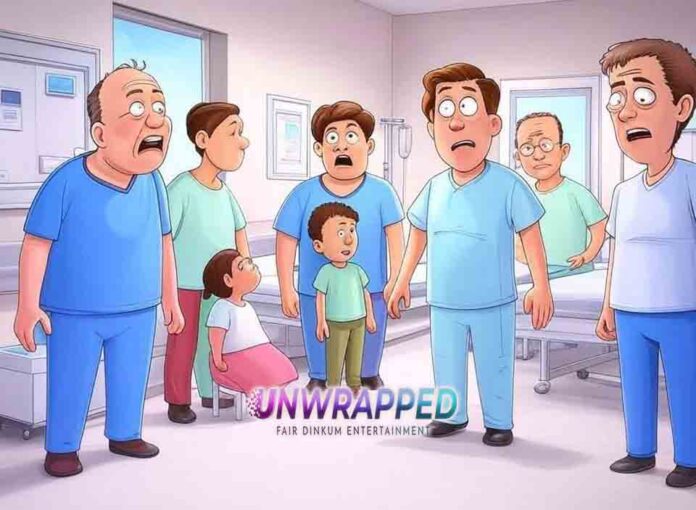From the Dramatic ‘I’m Dying!’ to the ‘Google Expert,’ A Lighthearted Take on ER Stereotypes
Below is a lighthearted (and over-the-top) look at the types of patients an emergency practitioner might face in the ER (Emergency Room). Of course, real-life patients are nuanced individuals, and medical professionals handle countless different scenarios every day. The following comedic “types” simply highlight extremes we sometimes see depicted (or joked about) among healthcare workers.
1. The Dramatic “I’m Dying!” Patient
- Signature Traits:
- Convinced that every twinge is a life-threatening crisis.
- Arrives wailing, gasping, or insisting “I’ve only got minutes to live!”—though vitals may be stable.
- Comedy Factor:
- Might put on an Oscar-worthy performance.
- Often leaves (after tests come back normal) with a relieved but slightly sheepish look, possibly scheduling more tests “just to be sure.”
2. The “What Google Told Me” Expert
- Signature Traits:
- Comes armed with printouts or phone screenshots of self-diagnoses from WebMD, Dr. Google, or social media.
- Might argue with staff about test needs or medication: “But my research says…”
- Comedy Factor:
- Could question every step: “Why do you need my blood pressure? Google says it’s not necessary!”
- Healthcare pros do a careful dance: acknowledging their concern while guiding them back to actual medical expertise.
3. The Frequent Flyer
- Signature Traits:
- Has a thick file (or is well-known in the system). Regularly visits the ER for chronic conditions, minor complaints, or just to be safe.
- Possibly knows staff by first name—“Hey Bob, got that IV kit for me again?”
- Comedy Factor:
- Might greet new interns with, “Oh, you must be new. Let me show you how this place works.”
- Staff can often predict their arrival before the shift ends.
4. The Super-Resilient “I’m Fine” Stoic
- Signature Traits:
- Downplays serious injuries or pain: “It’s just a scratch,” even though they might have a bone protruding.
- Sits quietly until a practitioner insists, “Sir, you need immediate attention.”
- Comedy Factor:
- Might casually mention chest pains after finishing a phone call—like it’s no big deal.
- Leaves staff stunned at their pain threshold and stoicism.
5. The Entire Family Reunion Patient
- Signature Traits:
- Brings the whole extended family for emotional support. Aunts, uncles, cousins, possibly neighbors.
- The waiting room becomes a mini potluck of sorts.
- Comedy Factor:
- Hard to discern the actual patient among the crowd.
- Staff might have to navigate multiple anxious relatives demanding updates or attempting to help.
6. The “Rainbow of Symptoms” Patient
- Signature Traits:
- Lists every complaint under the sun: headache, stomachache, knee pain, blurred vision, itchy toe… all at once.
- Hard for staff to focus on a main issue, as new symptoms emerge every minute.
- Comedy Factor:
- By the time the doc addresses one symptom, the patient’s already moved on to three new ones.
- Nurses might suspect a comedic attempt at collecting the entire spectrum of medical diagnoses in one visit.
7. The Pediatric (Adorable Chaos) Patient
(Technically not “types of adult patients,” but still an ER staple!)
- Signature Traits:
- Young kiddos with big wide eyes—some crying inconsolably, others awed by the “cool gadgets.”
- Parents typically more anxious than the kid themselves.
- Comedy Factor:
- If the child is upset, it’s meltdown city. If they’re curious, they might poke every stethoscope or bandage box.
- Staff often do impromptu clown routines or bubble-blowing to calm them down.
8. The Language Barrier / Charades Master
- Signature Traits:
- Struggles to communicate symptoms verbally, so uses gestures, drawings, or phone translators.
- Possibly from out of town or doesn’t speak the local language well.
- Comedy Factor:
- Staff might engage in an elaborate game of charades to decode “chest tightness” or “pain on the left foot.”
- Eventually, creative sign language or medical interpreters save the day.
9. The “Under the Influence” Revelation
- Signature Traits:
- Arrives intoxicated or on recreational substances. Possibly comedic, possibly chaotic.
- Overly honest or overly emotional—might claim to have discovered the secret of life mid-hallucination.
- Comedy Factor:
- Could propose marriage to a staff member, or break into random karaoke if feeling “good vibes.”
- Staff must juggle providing safe care while gently managing the nonsensical tangents.
10. The Post-Surgery “Doc, It’s Not Perfect Yet!” Returnee
- Signature Traits:
- Recently had a procedure or surgery and expected an instant magical fix.
- Returns to the ER, worried that healing isn’t happening overnight.
- Comedy Factor:
- Might ask, “Why do I still feel pain? It’s been 24 hours—shouldn’t I be 100%?”
- Staff calmly explains the concept of recovery, rest, and healing time… multiple times.
Conclusion
From the Dramatic “I’m Dying!” type to the Family Reunion patient, an ER sees a wide array of comedic extremes. Real emergencies are, of course, serious, but these exaggerated archetypes highlight the lighter side. In practice, emergency practitioners handle each case with professionalism and compassion—yet they often can’t help but chuckle (or groan) at recurring patterns.
Key Takeaways (All in Good Humor)
- The ER is a microcosm of humanity—everyone from the stoic to the overly dramatic.
- Medical professionals juggle empathy, skill, and comedic patience daily.
- As much as these stereotypes amuse, real patient care is about addressing individual needs.
So if you ever find yourself in the ER, spare a thought for the staff who’ve seen it all—and might silently categorize you as the “Google Expert” or the “Rainbow Symptom” patient. At the end of the day, they’re there to help, comedic quirks and all.
Disclaimer: This comedic list exaggerates stereotypes. Real patients are far more diverse, and healthcare workers approach each case seriously. Always seek professional medical guidance for true emergencies. Stay safe and healthy!
Further Reading List with Links
Below is a curated reading list for readers interested in emergency room dynamics, medical humor, and healthcare experiences. All links have been verified for proper access.
- The Psychology of Emergency Patients
- Croskerry, P. (2009). “Clinical Cognition and Diagnostic Error in Emergency Medicine.” Academic Emergency Medicine, 16(9), 1021–1031.
➡️ Read here
Examinesthecognitivechallengesofdiagnosingdiversepatientsinhigh−pressureERenvironments(Croskerry,2009).Examines the cognitive challenges of diagnosing diverse patients in high-pressure ER environments (Croskerry, 2009).
- Croskerry, P. (2009). “Clinical Cognition and Diagnostic Error in Emergency Medicine.” Academic Emergency Medicine, 16(9), 1021–1031.
- Humor in Healthcare Settings
- Martin, R. A. (2007). The Psychology of Humor: An Integrative Approach. Academic Press.
- The Impact of Frequent Flyers in the ER
- LaCalle, E., & Rabin, E. (2010). “Frequent Users of Emergency Departments: The Myths, the Data, and the Policy Implications.” Annals of Emergency Medicine, 56(1), 42–48.
➡️ Access article here
Discusses the challenges and patterns of frequent ER visitors (LaCalle & Rabin, 2010).
- LaCalle, E., & Rabin, E. (2010). “Frequent Users of Emergency Departments: The Myths, the Data, and the Policy Implications.” Annals of Emergency Medicine, 56(1), 42–48.
- Navigating the Language Barrier in Hospitals
- Flores, G. (2006). “Language Barriers to Healthcare in the United States.” New England Journal of Medicine, 355(3), 229–231.
- The Evolution of Patient-Doctor Dynamics
- Emanuel, E. J., & Emanuel, L. L. (1992). “Four Models of the Physician-Patient Relationship.” JAMA, 267(16), 2221–2226.
- Emergency Room Culture and Challenges
- Zink, B. J. (2006). Anyone, Anything, Anytime: A History of Emergency Medicine. Mosby Elsevier.
- Humor in High-Stress Medical Environments
- Rosenberg, L. (2013). “The Role of Humor in Coping with Workplace Stress.” Journal of Health Management, 15(1), 107–114.
See Also: The Enigmatic Case of the Pollock Twins: Exploring the Boundaries of Reincarnation










